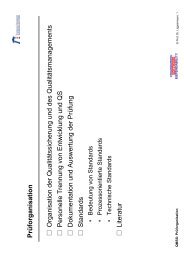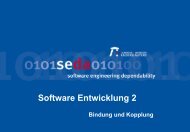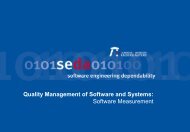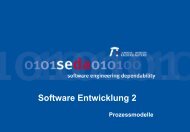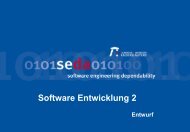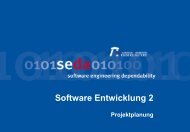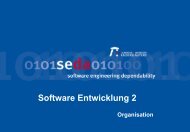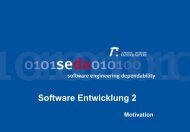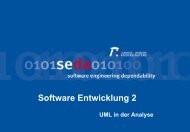Safety and Reliability of Embedded Systems - Software Engineering ...
Safety and Reliability of Embedded Systems - Software Engineering ...
Safety and Reliability of Embedded Systems - Software Engineering ...
Create successful ePaper yourself
Turn your PDF publications into a flip-book with our unique Google optimized e-Paper software.
Pr<strong>of</strong>. Dr. P. Liggesmeyer<br />
M.Sc. Carolina Gómez<br />
Technical University <strong>of</strong> Kaiserslautern<br />
Dept. <strong>of</strong> Computer Sciences<br />
AG S<strong>of</strong>tware <strong>Engineering</strong>: Dependability<br />
<strong>Safety</strong> <strong>and</strong> <strong>Reliability</strong> <strong>of</strong> <strong>Embedded</strong> <strong>Systems</strong><br />
(WS 11/12)<br />
Problem Set 3<br />
Problem 1:<br />
<strong>Reliability</strong> estimation by using RBD’s<br />
The safeguarding system <strong>of</strong> a railroad crossing consists <strong>of</strong> three heterogeneous controllers <strong>and</strong><br />
a component “C” that rectifies if any <strong>of</strong> them has failed. In normal conditions, the three controllers<br />
<strong>and</strong> “C” are functional. For the system to remain functional at least one controller <strong>and</strong><br />
“C” have to be functional. The three controllers fail independently from each other.<br />
1. Draw the corresponding reliability block diagram for the safeguarding system.<br />
To simplify the analysis <strong>of</strong> the safeguarding system, it is further assumed that C has a reliability<br />
R c <strong>of</strong> 1 which means that it never fails.<br />
2. Please calculate the reliability R sys <strong>of</strong> the safeguarding system if each controller has a<br />
reliability R ctrl = 0.95<br />
Problem 2:<br />
<strong>Reliability</strong> estimation by using Markov Processes<br />
Assume that the configuration <strong>of</strong> the safeguarding system has undergone some changes. Unlike<br />
the old configuration, the new one includes three controllers which are identical <strong>and</strong> there<br />
is no component “C”, which rectifies if the controllers have failed. In normal operating conditions,<br />
the total load <strong>of</strong> the safeguarding system is distributed equally among its controllers<br />
(Each controller runs at 1/3 <strong>of</strong> their maximum capacity). Whenever one controller fails, the<br />
remaining two take over its load (1/6). The system fails if two controllers have failed.<br />
1. Please draw the corresponding Markov process model under the assumption that if the<br />
complete safeguarding system has failed, the system remains in this state (no repair<br />
will take place).<br />
2. For the states <strong>of</strong> your Markov model, develop the set <strong>of</strong> related differential equations<br />
1
Problem 3: Petri Nets<br />
1. Please draw a Petri Net corresponding to the Markov Process <strong>of</strong> Problem 2. Which<br />
type <strong>of</strong> Petri Net would this be?<br />
2. Describe briefly the following Petri Net types: C/E Net, P/T Net, Pr/TNet, <strong>and</strong> SPN.<br />
How do they differ from each other?<br />
3. Consider the water pump example in the lecture (see chapter 4, page 44). If the repair<br />
strategy is changed to repair 2 pumps separately instead <strong>of</strong> repairing them together,<br />
how would you draw your Petri Net to reflect this situation?<br />
For your better underst<strong>and</strong>ing: Please draw the petri nets you have modeled in this<br />
problem as well as the C/E net <strong>of</strong> the assembling robot presented in Chapter 4 (Slide<br />
34), by using the following tool:<br />
www.ghannami.de//files/Netlab-0.1-win.zip<br />
2



